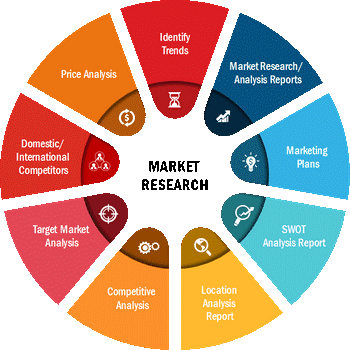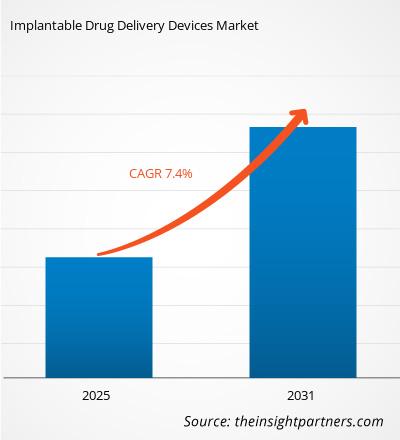Der Markt für implantierbare Arzneimittelverabreichungsgeräte wird voraussichtlich von 10,34 Milliarden US-Dollar im Jahr 2021 auf US-Dollar wachsen 16,87 Milliarden US-Dollar bis 2031. Von 2022 bis 2031 wird ein jährliches Wachstum von 7,4 % erwartet.
Implantierbare Geräte zur Medikamentenverabreichung geben Medikamente an den Blutkreislauf ab und bieten den Patienten kontinuierlich verschiedene Vorteile, wie zum Beispiel, dass Patienten nicht ins Krankenhaus eingeliefert werden müssen, um intravenöse Infusionen zu erhalten. Es gibt zwei Arten dieser Geräte: biologisch abbaubare Implantate und nicht biologisch abbaubare Implantate. Sie können für die ortsspezifische Arzneimittelabgabe verwendet werden, was in Anwendungen wie der Kardiologie und Onkologie wichtig ist.
MARKET DYNAMICS
Das Wachstum des implantierbare Arzneimittel Der Markt für Verabreichungsgeräte ist hauptsächlich auf die Verfügbarkeit technologisch fortschrittlicher Geräte zur Arzneimittelverabreichung, die steigende Nachfrage nach implantierbaren Koronar-Arzneimittel freisetzenden Stents und umfangreiche Forschung zu Technologien zur Arzneimittelverabreichung zurückzuführen. Darüber hinaus steigert das steigende Bewusstsein für Qualität und Verfügbarkeit auch die Gesamtnachfrage. Es wird erwartet, dass die zunehmende Akzeptanz von Arzneimittel-Geräte-Kombinationsprodukten aufgrund ihrer benutzerfreundlichen Eigenschaften mit höherer Wirksamkeit im Prognosezeitraum auch den Markt für implantierbare Arzneimittelverabreichungsgeräte ankurbeln wird. Strenge Vorschriften und Risiken im Zusammenhang mit implantierten Geräten behindern jedoch das Wachstum des Marktes.
MARKTUMFANG
Die Der Bericht „Globale Marktanalyse für implantierbare Arzneimittelverabreichungsgeräte bis 2031“ soll einen Überblick über den Markt für implantierbare Arzneimittelverabreichungsgeräte mit detaillierter Marktsegmentierung nach Produkttyp, Technologie und Anwendung geben. Der Bericht liefert wichtige Marktstatistiken basierend auf den Leistungen führender Akteure. Es bietet auch eine Analyse der wichtigsten Trends und Chancen auf dem Markt.
Strategische Einblicke< /strong>
MARKTSEGMENTIERUNG
Der globale Markt für implantierbare Arzneimittelverabreichungsgeräte ist in Produkttyp, Technologie und unterteilt Anwendung. Je nach Produkt ist der Markt in Verhütungsimplantate, Wirbelsäulenimplantate, Brachytherapie-Seeds, medikamentenfreisetzende Stents, bioabsorbierbare Stents, intraokulare Stents und Infusionspumpen. Basierend auf der Technologie ist der Markt in biologisch abbaubare Implantate und nicht biologisch abbaubare Implantate unterteilt. Basierend auf der Anwendung ist der Markt in Augenheilkunde, Onkologie, Herz-Kreislauf, Geburtenkontrolle, Opioidkonsumstörung und andere fragmentiert.
REGIONAL FRAMEWORK
Der weltweite Markt für implantierbare Arzneimittelverabreichungsgeräte ist in fünf Hauptregionen unterteilt: Nordamerika, Europa, Asien-Pazifik, Naher Osten und Asien. Afrika sowie Süd- und Afrika Zentralamerika. Der Bericht umfasst Analysen und Prognosen für 18 Länder weltweit sowie die in der Region vorherrschenden Trends und Chancen.
Aus regionaler Sicht dominierte Nordamerika den Markt für implantierbare Arzneimittelverabreichungsgeräte mit einem Marktanteil von ~37 % im Jahr 2021. Das Marktwachstum in der Region ist hauptsächlich auf den großen gezielten Patientenpool und umfangreiche Forschungs- und Entwicklungsaktivitäten zurückzuführen von führenden Spielern durchgeführt. Darüber hinaus treibt auch die hohe klinische Dringlichkeit, diese Geräte aufgrund der wachsenden Krankheitslast in der Region einzuführen, das Marktwachstum voran.
Die folgende Abbildung zeigt den Umsatzwachstumstrend auf dem Markt für implantierbare Arzneimittelverabreichungsgeräte in Nordamerika:
Quelle: The Analyse der Insight-Partner
Der Bericht analysiert Faktoren wie Treiber, Einschränkungen, Chancen und zukünftige Trends, die sich auf den Markt für implantierbare Arzneimittelverabreichungsgeräte auswirken. Es bietet außerdem eine umfassende Analyse der fünf Kräfte von Porter zu den Faktoren, die den Markt beeinflussen.
Für kurze Zeit störte die COVID-19-Pandemie den Markt für implantierbare Arzneimittelverabreichungsgeräte. Die Hauptprioritäten des medizinischen Fachpersonals sind die Coronavirus-Diagnose und die Betreuung ihrer Patienten. Seit Beginn der Pandemie verzögerte sich die Versorgung von Millionen von Patienten weltweit, da Krankenhäuser nicht dringende Operationen absagten. Aufgrund von Störungen durch COVID-19 wurden sehr viele Operationen abgesagt oder verschoben. Die Regierungen milderten diese große Patientenbelastung durch die Entwicklung von Wiederherstellungsplänen und die Umsetzung von Strategien zur sicheren Wiederherstellung der chirurgischen Aktivität. Aufgrund verschobener elektiver Eingriffe wird erwartet, dass der Markt für implantierbare Arzneimittelverabreichungsgeräte zurückgeht. Darüber hinaus wurde der Markt erheblich durch Lieferkettenbeschränkungen und verschobene elektive Operationen beeinträchtigt. Daher wird erwartet, dass der Markt für implantierbare Arzneimittelverabreichungsgeräte in naher Zukunft ein langsames Wachstum verzeichnen wird.
MARKTSPIELER
Der Bericht behandelt wichtige Entwicklungen auf dem Markt für implantierbare Arzneimittelverabreichungsgeräte. Verschiedene Unternehmen konzentrieren sich auf organische Wachstumsstrategien wie Produkteinführungen, Produktzulassungen, Patente und Veranstaltungen. Anorganische Wachstumsstrategien wie Akquisitionen, Partnerschaften und Kooperationen haben die Ausweitung von Geschäften und Kundenstämmen von Marktteilnehmern gefördert. Es wird erwartet, dass Akteure, die auf dem Markt für implantierbare Arzneimittelverabreichungsgeräte tätig sind, in den kommenden Jahren mit der steigenden Nachfrage nach diesen Geräten lukrative Wachstumschancen erleben werden.
Der Bericht enthält auch die Profile der wichtigsten Unternehmen sowie deren SWOT-Analyse und Marktstrategien. Darüber hinaus konzentriert es sich auf führende Branchenakteure mit Informationen wie Unternehmensprofilen, angebotenen Komponenten und Dienstleistungen, Finanzinformationen für die letzten drei Jahre und wichtigen Entwicklungen in den letzten fünf Jahren.
- Medtronic
- Psivida
- Bausch & Lomb Inc.
- Boston Scientific Corporation
- Merck & Co, Allergan
- Teleflex Incroporated
- Arrow International
- Cirtec
- < span style="Schriftfamilie: Verdana, Genf, serifenlos; Schriftgröße: 10pt;">TissueGen
- Delpor, Inc.
- Nanomedical Systems
- InnoCore Pharmaceutical
Das engagierte Forschungs- und Analyseteam des Insight Partners besteht aus erfahrenen Fachleuten mit fortgeschrittener Statistikkompetenz und bietet in dieser Studie verschiedene Anpassungsmöglichkeiten.

- Historische Analyse (2 Jahre), Basisjahr, Prognose (7 Jahre) mit CAGR
- PEST- und SWOT-Analyse
- Marktgröße Wert/Volumen – Global, Regional, Land
- Branche und Wettbewerbsumfeld
- Excel-Datensatz



Report Coverage
Revenue forecast, Company Analysis, Industry landscape, Growth factors, and Trends

Segment Covered
This text is related
to segments covered.

Regional Scope
North America, Europe, Asia Pacific, Middle East & Africa, South & Central America

Country Scope
This text is related
to country scope.
Trends and growth analysis reports related to Life Sciences : READ MORE..
The List of Companies
1. Medtronic
2. Psivida
3. Bausch & Lomb Inc.
4. Boston Scientific Corporation
5. Arrow International
6. Cirtec
7. TissueGen
8. Delpor, Inc.
9. Nanomedical Systems
10. InnoCore Pharmaceutical
The Insight Partners performs research in 4 major stages: Data Collection & Secondary Research, Primary Research, Data Analysis and Data Triangulation & Final Review.
- Data Collection and Secondary Research:
As a market research and consulting firm operating from a decade, we have published and advised several client across the globe. First step for any study will start with an assessment of currently available data and insights from existing reports. Further, historical and current market information is collected from Investor Presentations, Annual Reports, SEC Filings, etc., and other information related to company’s performance and market positioning are gathered from Paid Databases (Factiva, Hoovers, and Reuters) and various other publications available in public domain.
Several associations trade associates, technical forums, institutes, societies and organization are accessed to gain technical as well as market related insights through their publications such as research papers, blogs and press releases related to the studies are referred to get cues about the market. Further, white papers, journals, magazines, and other news articles published in last 3 years are scrutinized and analyzed to understand the current market trends.
- Primary Research:
The primarily interview analysis comprise of data obtained from industry participants interview and answers to survey questions gathered by in-house primary team.
For primary research, interviews are conducted with industry experts/CEOs/Marketing Managers/VPs/Subject Matter Experts from both demand and supply side to get a 360-degree view of the market. The primary team conducts several interviews based on the complexity of the markets to understand the various market trends and dynamics which makes research more credible and precise.
A typical research interview fulfils the following functions:
- Provides first-hand information on the market size, market trends, growth trends, competitive landscape, and outlook
- Validates and strengthens in-house secondary research findings
- Develops the analysis team’s expertise and market understanding
Primary research involves email interactions and telephone interviews for each market, category, segment, and sub-segment across geographies. The participants who typically take part in such a process include, but are not limited to:
- Industry participants: VPs, business development managers, market intelligence managers and national sales managers
- Outside experts: Valuation experts, research analysts and key opinion leaders specializing in the electronics and semiconductor industry.
Below is the breakup of our primary respondents by company, designation, and region:

Once we receive the confirmation from primary research sources or primary respondents, we finalize the base year market estimation and forecast the data as per the macroeconomic and microeconomic factors assessed during data collection.
- Data Analysis:
Once data is validated through both secondary as well as primary respondents, we finalize the market estimations by hypothesis formulation and factor analysis at regional and country level.
- Macro-Economic Factor Analysis:
We analyse macroeconomic indicators such the gross domestic product (GDP), increase in the demand for goods and services across industries, technological advancement, regional economic growth, governmental policies, the influence of COVID-19, PEST analysis, and other aspects. This analysis aids in setting benchmarks for various nations/regions and approximating market splits. Additionally, the general trend of the aforementioned components aid in determining the market's development possibilities.
- Country Level Data:
Various factors that are especially aligned to the country are taken into account to determine the market size for a certain area and country, including the presence of vendors, such as headquarters and offices, the country's GDP, demand patterns, and industry growth. To comprehend the market dynamics for the nation, a number of growth variables, inhibitors, application areas, and current market trends are researched. The aforementioned elements aid in determining the country's overall market's growth potential.
- Company Profile:
The “Table of Contents” is formulated by listing and analyzing more than 25 - 30 companies operating in the market ecosystem across geographies. However, we profile only 10 companies as a standard practice in our syndicate reports. These 10 companies comprise leading, emerging, and regional players. Nonetheless, our analysis is not restricted to the 10 listed companies, we also analyze other companies present in the market to develop a holistic view and understand the prevailing trends. The “Company Profiles” section in the report covers key facts, business description, products & services, financial information, SWOT analysis, and key developments. The financial information presented is extracted from the annual reports and official documents of the publicly listed companies. Upon collecting the information for the sections of respective companies, we verify them via various primary sources and then compile the data in respective company profiles. The company level information helps us in deriving the base number as well as in forecasting the market size.
- Developing Base Number:
Aggregation of sales statistics (2020-2022) and macro-economic factor, and other secondary and primary research insights are utilized to arrive at base number and related market shares for 2022. The data gaps are identified in this step and relevant market data is analyzed, collected from paid primary interviews or databases. On finalizing the base year market size, forecasts are developed on the basis of macro-economic, industry and market growth factors and company level analysis.
- Data Triangulation and Final Review:
The market findings and base year market size calculations are validated from supply as well as demand side. Demand side validations are based on macro-economic factor analysis and benchmarks for respective regions and countries. In case of supply side validations, revenues of major companies are estimated (in case not available) based on industry benchmark, approximate number of employees, product portfolio, and primary interviews revenues are gathered. Further revenue from target product/service segment is assessed to avoid overshooting of market statistics. In case of heavy deviations between supply and demand side values, all thes steps are repeated to achieve synchronization.
We follow an iterative model, wherein we share our research findings with Subject Matter Experts (SME’s) and Key Opinion Leaders (KOLs) until consensus view of the market is not formulated – this model negates any drastic deviation in the opinions of experts. Only validated and universally acceptable research findings are quoted in our reports.
We have important check points that we use to validate our research findings – which we call – data triangulation, where we validate the information, we generate from secondary sources with primary interviews and then we re-validate with our internal data bases and Subject matter experts. This comprehensive model enables us to deliver high quality, reliable data in shortest possible time.

 Holen Sie sich ein kostenloses Muster für diesen Bericht
Holen Sie sich ein kostenloses Muster für diesen Bericht